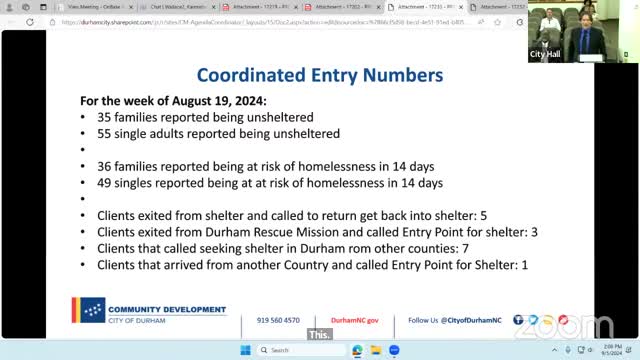Durham faces growing homelessness crisis as shelter capacity falls short
September 05, 2024 | Durham City, Durham County, North Carolina
This article was created by AI summarizing key points discussed. AI makes mistakes, so for full details and context, please refer to the video of the full meeting. Please report any errors so we can fix them. Report an error »

Durham's ongoing struggle with homelessness was a focal point during a recent government meeting, revealing alarming statistics and systemic challenges within the city's shelter system. Currently, 35 families and 55 single adults are reported as unsheltered and awaiting shelter beds, highlighting a significant gap between demand and available resources. The city's emergency shelter capacity includes only 50 beds for men, 15 for women, and 28 for families, which is insufficient to meet the needs of the community.
The waiting list for shelters remains high, with approximately 355 individuals and families seeking assistance. This number fluctuates based on various factors, including seasonal trends, with peaks often occurring after school years end or following holiday seasons. The meeting underscored the importance of understanding that the point-in-time count, conducted annually in January, only captures a snapshot of homelessness, suggesting that the actual number of individuals experiencing homelessness throughout the year is likely four times higher.
Participants discussed the challenges of providing adequate shelter, particularly for couples and medically fragile individuals, as well as the lack of facilities for families. The conversation also touched on the impact of rising housing costs and stricter landlord selection criteria, which have made it increasingly difficult for low-income families to secure permanent housing. The city has not added any new permanent supportive housing units since a previous analysis indicated a growing deficit.
Efforts to address these issues include revising prioritization policies to better match housing needs with available resources and exploring new funding sources for supportive services. The meeting concluded with a call for more comprehensive strategies to tackle the homelessness crisis, emphasizing the need for increased shelter capacity and permanent housing solutions. Council members expressed a commitment to ensuring that Durham's response to homelessness remains humane and effective, particularly as the community faces an influx of families and individuals seeking refuge.
The waiting list for shelters remains high, with approximately 355 individuals and families seeking assistance. This number fluctuates based on various factors, including seasonal trends, with peaks often occurring after school years end or following holiday seasons. The meeting underscored the importance of understanding that the point-in-time count, conducted annually in January, only captures a snapshot of homelessness, suggesting that the actual number of individuals experiencing homelessness throughout the year is likely four times higher.
Participants discussed the challenges of providing adequate shelter, particularly for couples and medically fragile individuals, as well as the lack of facilities for families. The conversation also touched on the impact of rising housing costs and stricter landlord selection criteria, which have made it increasingly difficult for low-income families to secure permanent housing. The city has not added any new permanent supportive housing units since a previous analysis indicated a growing deficit.
Efforts to address these issues include revising prioritization policies to better match housing needs with available resources and exploring new funding sources for supportive services. The meeting concluded with a call for more comprehensive strategies to tackle the homelessness crisis, emphasizing the need for increased shelter capacity and permanent housing solutions. Council members expressed a commitment to ensuring that Durham's response to homelessness remains humane and effective, particularly as the community faces an influx of families and individuals seeking refuge.
View full meeting
This article is based on a recent meeting—watch the full video and explore the complete transcript for deeper insights into the discussion.
View full meeting
